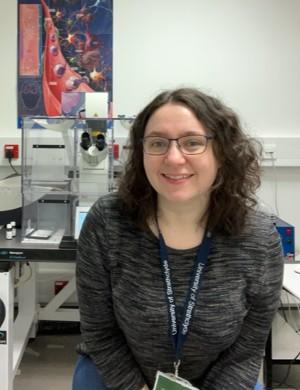In my research presented at the Diabetes UK Professional Conference 2022 (DUKPC22), I found that cave-like structures on the surface of fat cells are important for blood sugar control. This could further our understanding of type 2 diabetes.
Fat is often seen as something to lose or avoid altogether, but fat cells are vital for our health. When blood sugar rises after eating, fat cells can take in that sugar and use it for energy or store it to use later. This happens because insulin (which is released into the blood when blood sugar is high) acts as a messenger, telling fat cells to start taking in sugar. Insulin sends this message by attaching to proteins called insulin receptors, which sit on the surface of fat cells. This attachment is like turning a lock in a key, and it sets off a chain reaction inside the cell that results in the transport of sugar out of the blood and into the cell. This process is not yet fully understood- but we know that it doesn’t work well in people with type 2 diabetes. The aim of my PhD research is to better understand part of this chain reaction.
Exploring caves to understand blood sugar control

Fat cells don’t have a smooth surface as you might imagine. Instead, their surfaces are covered in tiny cave-like structures called caveolae. These caves are where the insulin receptors are found. Another important protein involved in getting sugar in to fat cells is called Syntaxin-4. In a test tube, the insulin receptor can activate Syntaxin-4, allowing it to do its job. I have been trying to find out whether the insulin receptor actually does this inside fat cells, and whether this happens in caveolae.
By isolating the parts of the fat cell surface that contain caveolae, I’ve been able to show that, just like the insulin receptor, Syntaxin-4 is found there too. For the insulin receptor to activate Syntaxin-4, they would have to be very physically close together in the cell. So I have used a powerful microscope-based technique that lets me look at tiny interactions between proteins, and this has shown that Syntaxin-4 and the insulin receptor do in fact interact. I have also found that when caveolae are disrupted, these interactions decrease.
How my research might help us better understand type 2 diabetes
This research is shedding light on the complicated process of sugar transport by fat cells. Once this process is understood, it is my hope that we will be able to better understand and treat type 2 diabetes.
I had the privilege of presenting this work at the recent Diabetes UK Professional Conference in the form of a poster. Though the event was mostly online, it was a fantastic experience to interact with fellow researchers and share questions and feedback on one another’s work. I also enjoyed virtually attending talks by healthcare professionals, taking a diabetes-focused look at everything from cancer to stem cell science. In my daily work doing lab-based cell biology, it can be easy to lose track of the real-life outcomes of diabetes research, so it was inspiring and motivating to hear from those working on the front lines of diabetes care.
About me
My name is Holly Taylor and I am a final-year PhD student at the University of Strathclyde in Glasgow. My research is funded by Diabetes UK. In my spare time I help run an amateur theatre company, and this year I am not only trying to finish my PhD, I am also planning my wedding for next summer!
More from DUKPC22
Hear more about the research presented at DUKPC22 from our guest bloggers Paul and Laura, who both live with type 1 diabetes.
